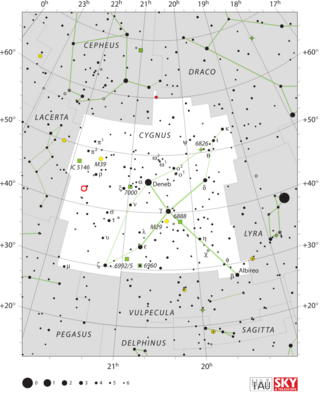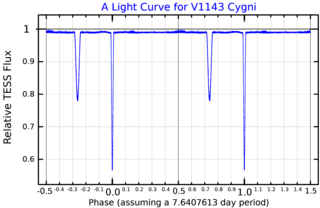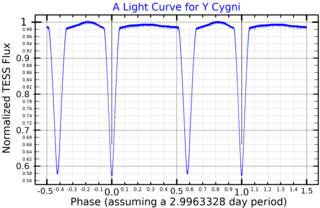
V1500 Cygni or Nova Cygni 1975 was a bright nova occurring in 1975 in the constellation Cygnus. It had the second highest intrinsic brightness of any nova of the 20th century, exceeded only by CP Puppis in 1942.

R Centauri is a Mira variable star in the constellation Centaurus.

Tau Cygni, Latinised from τ Cygni, is a binary star system in the constellation Cygnus, approximately 69 light years away from Earth. This visual binary system has a period of 49.6 years.

32 Cygni is the Flamsteed designation for a binary star system in the Cygnus constellation. It is a 4th magnitude star, which can be seen with the naked eye under suitably dark skies. Parallax measurements give an estimated distance of 1,100 light-years (320 parsecs) from the Earth. However, Schröder et al. (2007) suggest the actual value, after correcting for Malmquist bias, may be closer to 1,174 light-years (360 parsecs). Although it is a spectrsocopic binary with components that cannot be separated visually, it has two entries in the Henry Draper Catalogue, with identical magnitudes and positions, but showing the spectral types of the two components.

SS Cygni is a variable star in the northern constellation Cygnus. It is the prototype of the subclass of dwarf novae that show only normal eruptions. It typically rises from 12th magnitude to 8th magnitude for 1–2 days every 7 or 8 weeks. The northerly declination of SS Cygni makes the star almost circumpolar from European and North American latitudes, allowing a large proportion of the world's amateur astronomers to monitor its behavior. Furthermore, since the star lies against the rich backdrop of the Milky Way band, the telescope field of view around SS Cygni contains an abundance of useful brightness comparison stars.
Lambda Cygni is a class B5V star in the constellation Cygnus. Its apparent magnitude is 4.54 and it is approximately 770 light years away based on parallax.

47 Cygni is a triple star system in the northern constellation of Cygnus, and is located around 4,000 light years from the Earth. It is visible to the naked eye with a combined apparent visual magnitude of 4.61. The system is moving closer to the Earth with a heliocentric radial velocity of −4.6 km/s.

55 Cygni is a blue supergiant star in the constellation Cygnus. It is thought to be a member of the Cygnus OB7 stellar association at about 2,700 light years.

29 Cygni is a single star in the northern constellation of Cygnus. It is dimly visible to the naked eye as a white-hued star with an apparent visual magnitude of 4.93. The distance to 29 Cyg, as estimated from an annual parallax shift of 24.5 mas, is 133 light years. The star is moving closer to the Earth with a heliocentric radial velocity of −17 km/s. It is a member of the 30–50 million year old Argus Association of co-moving stars.
98 Herculis is a single star located approximately 590 light years from the Sun in the northern constellation Hercules. It is visible to the naked eye as a dim, red-hued point of light with an apparent visual magnitude of 4.96. The brightness of the star is diminished by an extinction of 0.19 due to interstellar dust. The star is moving closer to the Earth with a heliocentric radial velocity of −19 km/s.

W Cygni is a semi-regular variable star in the constellation Cygnus, located 570 light-years from Earth. It lies less than half a degree southeast of ρ Cygni. W Cygni is, at times, a naked-eye star but it was not given a Bayer or Flamsteed designation. It has been proposed as a binary star system with a hotter main sequence companion, but this has not been confirmed.

31 Cygni, also known as ο1 Cygni, Omicron1 Cygni, or V695 Cygni, is a triple star system about 750 light years away in the constellation Cygnus.

T Persei is a red supergiant located in the constellation Perseus. It varies in brightness between magnitudes 8.3 and 9.7 and is considered to be a member of the Double Cluster.

BC Cygni is a red supergiant and pulsating variable star of spectral type M3.5Ia in the constellation Cygnus.

RW Cygni is a semiregular variable star in the constellation Cygnus, about a degree east of 2nd magnitude γ Cygni. Its apparent magnitude varies between 8.05 and 9.70 and its spectral type between M3 and M4.

BI Cygni(BI Cyg, IRC +40408, BD+36 4025) is a red supergiant in the constellation Cygnus. It is an irregular variable star with a maximum brightness of magnitude 8.4 and a minimum of magnitude 9.9. It is considered a member of the stellar Cygnus OB1 association, its distance is around 2,600 parsecs (8,500 ly) of the Solar System. It is less than a degree south of another variable red supergiant, BC Cygni.

Q Cygni, is a star located in the constellation Cygnus. It is also known as Nova Cygni 1876, and has the designation NGC 7114, and HR 8296. Nova Cygni is located in the northwestern portion of Cygnus along the border with Lacerta.

HR 7484 is a binary star system in the northern constellation of Cygnus. It is dimly visible to the naked eye under good viewing conditions, having an apparent visual magnitude of 5.89. Based upon an annual parallax shift of 24.71, it is located 132 light years away. The system is moving closer with a heliocentric radial velocity of −14 km/s.

CH Cygni is a red giant, variable, symbiotic binary in the constellation Cygnus. It is the nearest symbiotic star to Earth, and one of the brightest, making it an ideal candidate for study.

Y Cygni is an eclipsing and double-lined spectroscopic binary star system in the constellation of Cygnus. It is located about 4,900 light-years from Earth. The system was one of the first binaries with a convincing detection of the apsidal precession.












